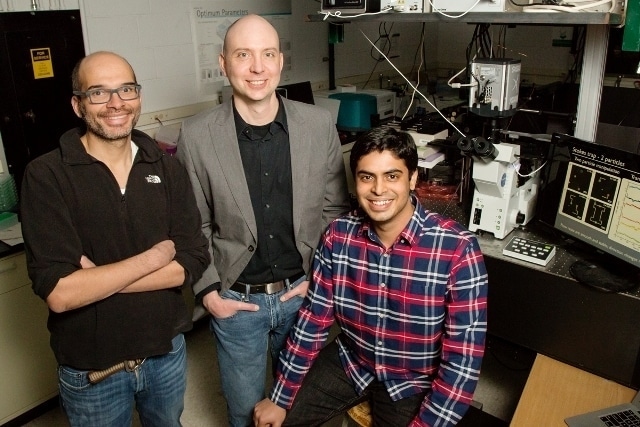Mar 29 2016
Precise control of an individual particle or molecule is a difficult task. Controlling multiple particles simultaneously is an even more challenging endeavor. Researchers at the University of Illinois have developed a new method that relies on fluid flow to manipulate and assemble multiple particles. This new technique can trap a range of submicron- to micron-sized particles, including single DNA molecules, vesicles, drops or cells.
 From left, Illinois professors Christopher Rao and Charles Schroeder with graduate student Anish Shenoy developed a new method for controlling multiple particles. (Photo by L. Brian Stauffer)
From left, Illinois professors Christopher Rao and Charles Schroeder with graduate student Anish Shenoy developed a new method for controlling multiple particles. (Photo by L. Brian Stauffer)
“This is a fundamentally new method for trapping multiple particles in solution,” said Charles M. Schroeder, a U. of I. professor of chemical and biomolecular engineering. Schroeder conducted the research with mechanical science and engineering graduate student Anish Shenoy and chemical and biomolecular engineering professor Christopher Rao.
The study results were reported in the Proceedings of the National Academy of Sciences.
Many methods exist for particle trapping, with each type using a different modality for trapping – including optical, magnetic, acoustic and electrical forces. However, many of these techniques change or perturb the system that is being observed.
“The existing techniques can be very restrictive in particle properties required for trapping, and we wanted to study a broad range of systems like bacterial cells and different types of soft particles like vesicles, bubbles and droplets,” Shenoy said. None of the prevailing techniques can be used for studying this broad range of systems across multiple length scales, he said. Thus, the researchers wanted to build a technique that could be generally applied to arbitrary numbers of arbitrary kinds of particles.
Called the Stokes Trap, the method developed by Schroeder’s team relies on gentle fluid flow to manipulate particles. Schroeder’s group is the first to implement multiple particle trapping and assembly using fluid flow.
In order to control the movement of the particles from a set starting position to a set ending position, Shenoy and his colleagues developed an automated control algorithm that calculates which pressures are required to drive the flow fields and precisely move the particles in a small microdevice. The algorithm can solve the complex optimization problem in half a millisecond, he said.
“There are multiple parameters involved in the controller, and that’s the complicated part of it,” Schroeder said.
The control program is designed to calculate the particles’ distance from a target position and move them efficiently by minimizing the flow rate necessary to move the particles. It also will allow researchers to assemble multiple particles into arbitrary, complex structures and to probe interactions between two or more particles.
The group hopes the Stokes Trap will become as universal as other commonly used trapping methods.
“This is not only another method in the toolbox but it also has several advantages over other methods,” Schroeder said. “As long as you can see a particle and detect it in some way, you can trap it.”
This research was supported by an FMC Educational Fund Fellowship; a Packard Fellowship from the David and Lucile Packard Foundation; and an NSF CAREER Award (CBET 1254340) from the National Science Foundation.